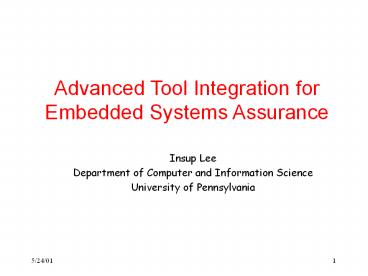Advanced Tool Integration for Embedded Systems Assurance PowerPoint PPT Presentation
Title: Advanced Tool Integration for Embedded Systems Assurance
1
Advanced Tool Integration for Embedded Systems
Assurance
- Insup Lee
- Department of Computer and Information Science
- University of Pennsylvania
2
People
- University of Pennsylvania
- Rajeev Alur
- Carl A. Gunter
- Sampath Kannan
- Insup Lee (PI)
- Oleg Sokolsky
- George Southern University
- Robert P. Cook
- New Jersey Institute of Technology
- Elsa Gunter
- University of Michigan
- Kang G. Shin
3
Embedded Systems
- Difficulties
- Increasing complexity
- Decentralized
- Safety critical
- Resource constrained
- Non-functional power, size, etc.
- Development of reliable and robust embedded
software - Increased development cost implies greater
emphasis on reuse
4
Properties of embedded systems
- Adherence to safety-critical properties
- Meeting timing constraints
- Satisfaction of resource constraints
- Confinement of resource accesses
- Supporting fault tolerance
- Domain specific requirements
- Mobility
- Software configuration
5
Goals of the HASTEN Project
- High Assurance Systems Tools and ENvironments
(HASTEN) - Develop tools for end-to-end software
engineering - Requirements capture
- Specification, analysis, simulation
- Implementation testing
- Deployed system monitoring and checking
- Integrated use of tools
- Vertical integration
- Horizontal integration
- Case studies
- automotive controllers, mobile robots, medical
devices, real-time Java, embedded Linux
6
Monitoring
Requirements Artifacts
Informal Requirements
Requirements Engineering
Formal Requirements
System Artifacts
Informal Design Diagrams (UML)
Verification
Prototype
Formal Specification
Implementation
7
Vertical integration scenario
SCR
Charon
interface
discrete abstraction
diagnostics
Mocha
MEDL generator
code generation
MaCS
MEDL
8
Horizontal integration scenario
UML-RT
Paragon
Charon
scheduling assumptions
task model
9
Research Plan Year 1
- Extend the reference model to deal with resource
constraints of embedded systems. - Define programming interfaces for embedded
systems. - Develop techniques for prototype simulator
systems for representative classes of embedded
systems and requirements used in the reference
model. - Extend ACSR with resource usage primitives and
develop algorithms to bound power use of an ACSR
specification. - Define real-time and resource extensions to UML
and explore the use of bisimulation checking and
model checking as analysis techniques for UML. - Develop test coverage criteria based on formal
specifications. - Explore the integration of Charon and Paragon.
- Identify and evaluate various embedded systems
for potential case study candidates (e.g., WARIR
Infusion Pump, automotive controllers, networked
embedded systems).
10
Year 2
- Demonstrate advances in automated reasoning about
resource constraints of embedded systems for the
reference model. - Implement the resource usage analysis algorithms
for ACSR and integrate them into PARAGON. - Develop techniques for RT-UML schedulability
analysis and formal verification using the HASTEN
analysis tools (i.e., integrate RT-UML and
Paragon). - Develop an initial Explore automatic derivation
of intermediate constraints from e2e constraints. - Develop and implement test generation algorithms
based on formal specifications. - Develop abstraction techniques (Bandera-style)
for Charon and integrate them into the HASTEN
tools. - Develop the XML-based description tags for HASTEN
artifacts. - Develop algorithms to generate MaCS scripts from
the requirements specifications, starting with
SCR. - Develop an initial methodology for the integrated
use of the HASTEN tools.
11
Year 3
- Refine the application of the reference model for
formal requirements specifications, analysis, and
simulation in the HASTEN tools. - Define a runtime execution model in UML to
facilitate schedulability analysis and carry out
case studies. - Integrate the runtime execution model into the
code generator of the UML and Charon tool. - Integrate test generator with MaCS, in
particular, extend the MaCS to be used as test
execution oracle. - Complete the integration of MaCS and SCR.
- Develop the heuristics for exploiting
hierarchical structures for efficient model
checking. - Perform case studies to evaluate the methodology
for the integrated use of HASTEN tools.
12
Year 4
- Refine a prototype embedded system simulator kit
for the reference model to handle more advanced
modeling and analysis of a representative class
of embedded systems - Complete the integration of the simulator kit
with MaCS - Perform a medium-size case study to assess the
new abstraction and analysis techniques in the
HASTEN tools. - Refine a software development methodology that
takes advantage of the integrated environment and
new analysis techniques. - Explore technology transition possibilities by
releasing the beta version of HASTEN.
13
Year 5
- Assess the developed technology on a realistic,
large-scale case study. - Refine the methodology and improve analysis
techniques for large scale systems - Quantify improvements in terms of shortened
development cycle and improved product quality. - Complete technology transition of the new
technology into DoD and commercial applications.
14
Technical Talks
- Tools for formal modeling and verification,
Rajeev Alur - Referece Model, Elsa Gunter
- Resouce-bound family of real-time process
algebras, Oleg Sokolsky - Streaming checking, Sampath Kannan
- Monitoring and Checking, Testing, Insup Lee
- Verisim formal analysis of network
simulations, Carl Gunter - End-to-end design of embedded real-time
systems, Kang G. Shin

